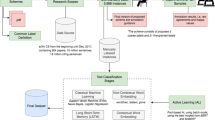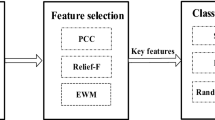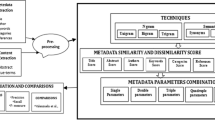Abstract
Given that citations are not equally important, various techniques have been presented to identify important citations on the basis of supervised machine learning models. However, only a small volume of instances have been annotated manually with the labels. To make full use of unlabeled instances and promote the identification performance, the semi-supervised self-training technique is utilized here to identify important citations in this work. After six groups of features are engineered, the SVM and RF models are chosen as the base classifiers for self-training strategy. Then two experiments based on two different types of datasets are conducted. The experiment on the expert-labeled dataset from one single discipline shows that the semi-supervised versions of SVM and RF models significantly improve the performance of the conventional supervised versions when unannotated samples under 75% and 95% confidence level are rejoined to the training set, respectively. The AUC-PR and AUC-ROC of SVM model are 0.8102 and 0.9622, and those of RF model reach 0.9248 and 0.9841, which outperform their counterparts and the benchmark methods in the literature. This demonstrates the effectiveness of our semi-supervised self-training strategy for important citation identification. Another experiment on the author-labeled dataset from multiple disciplines, semi-supervised learning models can perform better than their supervised learning counterparts in term of AUC-PR when the ratio of labeled instances is less than 20%. Compared to our first experiment, insufficient amount of instances from each discipline in our second experiment enables the performance of the models to be unsatisfactory.






Similar content being viewed by others
References
Abu-Jbara, A., Ezra, J., & Radev, D. (2013). Purpose and polarity of citation: Towards NLP-based bibliometrics. In Proceedings of the 2013 Conference of the North American Chapter of the Association for Computational Linguistics: Human Language Technologies (pp. 596–606).
Aljuaid, H., Iftikhar, R., Ahmad, S., Asif, M., & Afzal, M. T. (2021). Important citation identification using sentiment analysis of in-text citations. Telematics and Informatics, 56, 101492.
An, X., Sun X., Xu, S. (2021b). Important citations identification with semi-supervised classification model. The first Workshop on AI + Informetrics at the iConference 2021.
An, X., Sun, X., Xu, S., Hao, L., & Li, J. (2021a). Important citations identification by exploiting generative model into discriminative model. Journal of Information Science. https://doi.org/10.1177/0165551521991034
Bennett, K., & Demiriz, A. (1999). Semi-supervised support vector machines. Advances in Neural Information Processing Systems, 368–374.
Blum, A., & Mitchell, T. (1998). Combining labeled and unlabeled data with co-training. In Proceedings of the 11th Annual Conference on Computational Learning Theory (pp. 92–100).
Blum, A., & Chawla, S. (2001). Learning from labeled and unlabeled data using graph mincuts. In Proceedings of the 18th International Conference on Machine Learning (pp. 19–26).
Chapelle, O., Sindhwani, V., & Keerthi, S. S. (2008). Optimization techniques for semi-supervised support vector machines. Journal of Machine Learning Research, 9(2), 203–233.
Councill, I. G., Giles, C. L., & Kan, M. Y. (2008). ParsCit: An open-source CRF reference string parsing package. In Proceedings of the 6th International Conference on Language Resources and Evaluation (pp. 661–667).
Davis, J., & Goadrich, M. (2006). The relationship between Precision-Recall and ROC curves. In Proceedings of the 23rd International Conference on Machine Learning (pp. 233–240).
Dietz, L., Bickel, S., & Scheffer, T. (2007). Unsupervised prediction of citation influences. In Proceedings of the 24th International Conference on Machine Learning (pp. 233–240). ACM.
Dong, C., & Schäfer, U. (2011). Ensemble-style self-training on citation classification. In Proceedings of 5th International Joint Conference on Natural Language Processing (pp. 623–631).
Garfield E. (1965). Can citation indexing be automated. In Proceedings of the Symposium on Statistical Association Methods for Mechanized documentation (pp. 189–192).
Garfield, E. (2006). Citation indexes for science. A new dimension in documentation through association of ideas. International Journal of Epidemiology, 35(5), 1123–1127.
Hassan, S. U., Akram, A., & Haddawy, P. (2017). Identifying important citations using contextual information from full text. In Proceedings of the 17th ACM/IEEE Joint Conference on Digital Libraries (JCDL) (pp. 1–8). IEEE.
Hassan, S. U., Imran, M., Iqbal, S., Aljohani, N. R., & Nawaz, R. (2018a). Deep context of citations using machine-learning models in scholarly full-text articles. Scientometrics, 117(3), 1645–1662.
Hassan, S. U., Safder, I., Akram, A., & Kamiran, F. (2018b). A novel machine-learning approach to measuring scientific knowledge flows using citation context analysis. Scientometrics, 116(2), 973–996.
He, Y., & Zhou, D. (2011). Self-training from labeled features for sentiment analysis. Information Processing and Management, 47(4), 606–616.
Hirsch, J. E. (2005). An index to quantify an individual’s scientific research output. Proceedings of the National Academy of Sciences, 102(46), 16569–16572.
Iqbal, S., Hassan, S. U., Aljohani, N. R., Alelyani, S., Nawaz, R., & Bornmann, L. (2021). A decade of in-text citation analysis based on natural language processing and machine learning techniques: An overview of empirical studies. Scientometrics, 126(8), 6551–6599.
Joachims, T. (1999). Transductive inference for text classification using support vector machines. In Proceedings of the 16th International Conference on Machine Learning (pp. 200–209).
Lazaridis, T. (2010). Ranking university departments using the mean h-index. Scientometrics, 82(2), 211–216.
Li, X., He, Y., Meyers, A., & Grishman, R. (2013, September). Towards fine-grained citation function classification. In Proceedings of the International Conference on Recent Advances in Natural Language Processing (pp. 402–407).
Li, Y., Guan, C., Li, H., & Chin, Z. (2008). A self-training semi-supervised SVM algorithm and its application in an EEG-based brain computer interface speller system. Pattern Recognition Letters, 29(9), 1285–1294.
Qayyum, F., & Afzal, M. T. (2019). Identification of important citations by exploiting research articles’ metadata and cue-terms from content. Scientometrics, 118(1), 21–43.
Radoulov, R. (2008). Exploring automatic citation classification. Master's thesis, University of Waterloo.
Rosenberg, C., Hebert, M., & Schneiderman, H. (2005). Semi-supervised self-training of object detection models. In Proceedings of the 7th IEEE Workshop on Applications of Computer Vision (pp. 29–36).
Tanha, J., van Someren, M., & Afsarmanesh, H. (2017). Semi-supervised self-training for decision tree classifiers. International Journal of Machine Learning and Cybernetics, 8(1), 355–370.
Teufel, S., Siddharthan, A., & Tidhar, D. (2006). Automatic classification of citation function. In Proceedings of the 2006 Conference on Empirical Methods in Natural Language Processing (pp. 103–110).
Valenzuela, M., Ha, V., & Etzioni, O. (2015). Identifying meaningful citations. In The 2015 AAAI Workshop on Scholarly Big Data: AI Perspectives, Challenges, and Ideas (pp. 21–26).
Van Engelen, J. E., & Hoos, H. H. (2020). A survey on semi-supervised learning. Machine Learning, 109(2), 373–440.
Vapnik, V. (1998). Statistical learning theory. Springer.
Wang, B., Spencer, B., Ling, C. X., & Zhang, H. (2008). Semi-supervised self-training for sentence subjectivity classification. In Proceedings of the 21st Conference of the Canadian Society for Computational Studies of Intelligence (pp. 344–355). Springer, Berlin, Heidelberg.
Wang, M., Zhang, J., Jiao, S., Zhang, X., Zhu, N., & Chen, G. (2020). Important citation identification by exploiting the syntactic and contextual information of citations. Scientometrics, 125(3), 2109–2129.
Xu, S., Ma, F., & Tao, L. (2007). Learn from the information contained in the false splice sites as well as in the true splice sites using SVM. In Proceedings of the International Conference on Intelligent Systems and Knowledge Engineering (pp. 65–71). Atlantis Press.
Xu, S., An, X., Qiao, X., Zhu, L., & Li, L. (2011). Semi-supervised least-squares support vector regression machines. Journal of Information and Computational Science, 8(6), 885–892.
Xu, S., Hao, L., An, X., Yang, G., & Wang, F. (2019). Emerging research topics detection with multiple machine learning models. Journal of Informetrics, 13(4), 100983.
Yarowsky, D. (1995). Unsupervised word sense disambiguation rivaling supervised methods. In Proceedings of the 33rd Annual Meeting of the Association for Computational Linguistics (pp. 189–196).
Zeng, T., & Acuna, D. E. (2020). Modeling citation worthiness by using attention-based bidirectional long short-term memory networks and interpretable models. Scientometrics, 124(1), 399–428.
Zhang, F., Pan, T., & Wang, B. (2021). Semi-supervised object detection with adaptive class-rebalancing self-training. arXiv preprint. arXiv:2107.05031.
Zhu, X., Ghahramani, Z., & Lafferty, J. D. (2003). Semi-supervised learning using gaussian fields and harmonic functions. In Proceedings of the 20th International Conference on Machine learning (pp. 912–919).
Zhu, X., Lafferty, J., & Rosenfeld, R. (2005). Semi-supervised learning with graphs. Doctoral dissertation. Carnegie Mellon University.
Zhu, X. J. (2008). Semi-supervised learning literature survey. Technical Report. University of Wisconsin-Madison.
Zhu, X., Turney, P., Lemire, D., & Vellino, A. (2015). Measuring academic influence: Not all citations are equal. Journal of the Association for Information Science and Technology, 66(2), 408–427.
Acknowledgements
The present study is an extended version of an article (An et al., 2021b) presented at the first Workshop on AI + Informetrics at the iConference 2021, 17 March, 2021. This research received the financial support from the National Natural Science Foundation of China under grant number 72004012 and 72074014.
Author information
Authors and Affiliations
Corresponding author
Rights and permissions
About this article
Cite this article
An, X., Sun, X. & Xu, S. Important citations identification with semi-supervised classification model. Scientometrics 127, 6533–6555 (2022). https://doi.org/10.1007/s11192-021-04212-6
Received:
Accepted:
Published:
Issue Date:
DOI: https://doi.org/10.1007/s11192-021-04212-6




